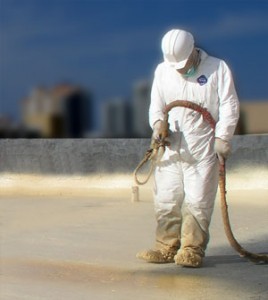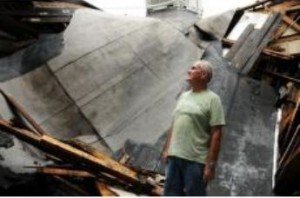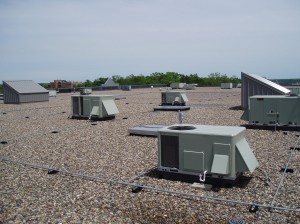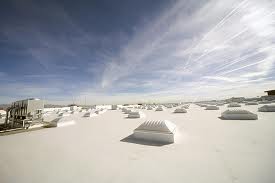Archive for the ‘Commerical Roofs’ Category
Spray Foam Roofing Benefits For Commercial Roofs
 Most commercial buildings pose unique challenges to the maintenance of its roof. With very little slope and often plagued by large structures, commercial roofs must be innovative with their choice of roof materials.
Most commercial buildings pose unique challenges to the maintenance of its roof. With very little slope and often plagued by large structures, commercial roofs must be innovative with their choice of roof materials.
In the past, many roof systems used tar and rubber coatings to keep out moisture and protect the integrity of the roof. As technology changes, so does the materials and procedures available for roof repair and maintenance.
Spray Foam Systems
A new trend in commercial roofing is using a spray foam coating. Similar to the product used to dispense attic insulation, a spray foam roof uses a lightweight product that spreads easily and dries hard. Not only can a commercial roofer cover large areas in half the time, the spray foam material is a far superior product to concrete or rubber roof materials.
A roof covered in spray foam is highly water resistant and holds a great insulation value. This roof material is self-flashing, which reduces the chances of water leakage, and is more durable than traditional commercial roof materials. The polyurethane foam contains an SPF factor that increases is durability makes it more resistant to the sun’s UV rays.
Further, spray foam roofing is an Energy Star rated product, meaning it adheres to the environmental standards set forth by the government as reducing the dependence on traditional energy. A properly installed spray foal roof can lower the temperature of a roof by up to 100 degrees F through its high reflectivity coating, making it a green roof product of its own kind.
White Roof Codes
Some states already have codes in place for implementing the cooler white roofs on commercial buildings. White roofs stay cool in the sun by minimizing the sun’s absorption and maximizing thermal emission and are considered “cool roofs”. The light colored reflective roofs bounce sunlight back and reduce the urban heat-island effect.
Scientists at Lawrence Berkeley National Laboratory are advocating light roofing materials in building codes. Not only do the light roofs cut heat that is absorbed into the building but it also cuts carbon emissions by reducing air-condition use. The scientists’ calculated one average size house emits 10 tons of carbon dioxide per year.
Building Codes
Since 1999 several widely used building standard codes have adopted cool roof credits or requirements. In 2005 California building code Title 24 was enacted to require modified flat roofs to be white or light in color. That law was updated in 2008 to include residential sloped roofs in California’s 5 hottest zones. Several US cities and Arizona, Hawaii, Georgia and Florida have similar building codes.
According to Global Cool Cities Alliance, for the first time in human history over half the world’s population lives in urban areas. Most roofing materials are dark and typically absorb over 80% of incoming sunlight, converting it into heat. Cool roofs transfer less heat to the environment, resulting in a decrease in the outside air temperature creating cooler and cleaner city air.
Roofing Help For Business Owners
 After Hurricane Irene, many business owners are returning to their businesses to survey the damage left behind. Many businesses will have severe roof damage caused by flying debris and high winds; while others may need to replace a roof that collapsed during the storm. For business owners, roof repair costs can easily exceed tens of thousands of dollars.
After Hurricane Irene, many business owners are returning to their businesses to survey the damage left behind. Many businesses will have severe roof damage caused by flying debris and high winds; while others may need to replace a roof that collapsed during the storm. For business owners, roof repair costs can easily exceed tens of thousands of dollars.
Commercial roofs pose unique challenges when it comes to weather resistance and preventative maintenance. As storms such as Irene approach, many businesses board up windows and doors to keep out the rain. Unfortunately, many businesses forget about protecting their roof from the elements.
Checking Your Roof, Saving Your Business
As a business owner it is your responsibility to make sure your roof is properly maintained, especially before a large storm. There are a few ways to ensure your roof is maintained and you are prepared before any major weather event.
Have your roof inspected. Roofs should be inspected by a professional roof contractor at least once a year. If a weather event is predicted, have a roofer inspect your roof for damage and carry out any necessary repairs. Get a copy of the inspection report, which you may need to provide to the insurance company if any claim is filed after the storm.
Contact your insurance company. It is always a good idea to know what is and is not covered under your insurance policy at all times. Ask if they have any preventative maintenance clauses, which may exclude certain damages from your claim.
Document the evidence. Filing an insurance claim for damages can be a tedious process. Having all of your documentation about your roof can expedite the process. Take before and after pictures of the roof to send in along with your claim. Make sure you have any inspection, both before and after, the storm included in your claim.
Commercial Roof Challenges
 Keeping a well maintained roof is a challenge for any home or business owner. The weather, pests and debris can all threaten the integrity of a roof. Both residential and commercial roofs have their own challenges in terms of general maintenance and upkeep. However, commercial roofs pose unique problems that should be considered by any business owner.
Keeping a well maintained roof is a challenge for any home or business owner. The weather, pests and debris can all threaten the integrity of a roof. Both residential and commercial roofs have their own challenges in terms of general maintenance and upkeep. However, commercial roofs pose unique problems that should be considered by any business owner.
Roof Leaks
Commercial roofs are different from residential roofs in many ways, the main difference being the shape of the roof. Most commercial roofs are flat or carry less of a slope than residential roofs. Without a significant slope, water cannot drain properly and may accumulate on the roof. When water begins to pool on top of the roof, the constant moisture causes weak spots in the roof and results in water damage. Water damage can cause many costly repairs such as mold or mildew to the roof materials, and even risk having the roof collapse.
Traditionally, the metal flashing bridges the gap along a roof transition in between materials or between the roof and an additional structure. In many cases, commercial roofs may lack adequate, if any, flashing because of the type of roof material used. In older roofs, hot tar and rubber would be used to coat the top of the roof. This roof material was once thought to create a water tight seal along the roof, but has since been determined to be less effective due to severe cracking between joints. This is especially true in hotter climates, where roofs made out of cement or hot tar tend to flex in the heat and causes cracking along the roof.
Roof Damage and Debris
Commercial roofs are more susceptible to damage and debris than residential roofs because of (a) their size, (b) their shape and (c) their location. Since many commercial roofs are large and flat, animals find it easy to build nests or hang around to spot prey. Animal waste can be toxic and acidic, resulting in damage to the roof. Commercial roofs also tend to have large structures, such as air conditioner units and ventilation caps, which make finding shelter from predators or the weather easier for many animals. Trash and other debris blowing in the wind may also get stuck in ventilation caps or large roof structures. If the debris is not cleaned out or removed, the resulting damage can be a costly roof repair.







